| The Jewish Cemetery | |
|---|---|
.jpg.webp) | |
| Artist | Jacob van Ruisdael |
| Year | 1654 or 1655 |
| Medium | Oil on canvas |
| Dimensions | 142.2 cm × 189.2 cm (56.0 in × 74.5 in) |
| Location | Detroit Institute of Arts, Detroit, MI 48202 |
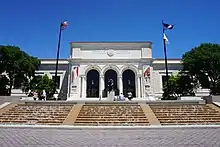
The Jewish Cemetery is an oil-on-canvas painting by the Dutch landscape painter Jacob van Ruisdael, now at the Detroit Institute of Arts.[1] While growing up in Haarlem, his father, Isaak van Ruisdael, and uncle Salomon van Ruisdael taught him painting. The Jewish Cemetery is an allegorical painting depicting hope and death,[2] while also depicting Beth Haim, a cemetery located on Amsterdam's outskirts. Beth Haim is a prominent resting place for Amsterdam's large Jewish Portuguese community.[3] The tomb monuments depicted commemorate the leaders of the newly arrived Portuguese-Jewish community.[1] The central elements of the painting, however, are different than one would see in Ouderkerk, as Ruisdael made adjustments to achieve the painting's compositional and allegorical intent.[2] This painting is twice as large as the typical landscape painting from the 17th century.[3] After being cataloged in England in 1835, the artwork, The Jewish Cemetery, disappeared from public display for many years,[4] before coming back on the radar through various auctions in London and Berlin.[2][5] The Detroit Institute of Arts acquired the painting in 1926 when it was gifted by Julius H. Haass, in memory of his brother.[6]
Jacob van Ruisdael painted two versions of The Jewish Cemetery in 1653 and 1655 and was said to be in his mid-twenties, according to Erich Simon.[1]
Subject and symbols
In his painting, Jacob van Ruisdael presents the cemetery as a landscape variant of a vanitas painting.[7] Vanitas paintings tend to be still-life's or genre scenes, with skulls, books, flowers, and candles are common subjects in this theme.[8] Similarly, Jacob van Ruisdael used deserted tombs, ravaged churches, stormy clouds, dead trees, changing skies, and flowing water to symbolize death and the transience of all earthly things.[2]
The building foundations are overrun by leafy foliage arising from decaying wood in the foreground.[2] In the artwork, there are many symbols of death.[1] As the brook rushes over large stones under the broken arch, it symbolizes life's fast-flowing flow. Similarly, it corresponds to light beams that break through billowing rain or storm clouds in the upper sphere. The upright but broken column, here presented as a half-cylinder, signifies death.[7] In addition to serving as a memento mori, a reminder of death's inevitability, the painting also contains themes of hope and renewal. Water constantly flows, changes, and regenerates in the stream, symbolizing life while the decaying tree bending over it represents death's inevitable arrival.[7] Although the rainbow has many meanings, it is generally regarded as a symbol of hope and divine promise. At the top of the picture, the curve in the rainbow arc, is like a bridge to the heavens.[7] It has also been theorized to symbolize the renewal of life, connecting the work to a theological message, as rabbis have said that the resurrection of the dead would be the first sign that the moshiach (the anointed one from the House of David) is coming. This message would be clear to Portuguese Jews, who would wait for this event within Beth Chaim, the cemetery that the tombs depicted in this painting are located in. It is possible that this added meaning would have been at the direction of a patron, though it is unknown who, if anyone, commissioned the painting.[2] Nature revitalizes and replenishes neglected areas as they become submerged in encroaching woodland over time.[8]
Tombs
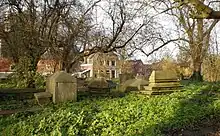
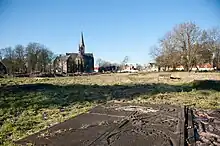
Ruisdael's paintings depicts numerous tombs in his work that were pulled from what he would have seen when visiting Beth Hamin. These were the first Portuguese settlers in Amsterdam at the time, many of whom were from old families that had obtained wealth and noble titles before coming to Amsterdam.[1] In the illuminated white marble tombstone, adorned with a large stone box and colorful cap, lie the remains of Elias (or Eliahu) Montalto. Dr. Eliahu Montalto's first name is spelled out in an acrostic poem on the vertical rear plate. Inscribed on the marble slab are Hebrew block letters.[2] Dr. Montalto was the physician to Maria de' Medici and upon his death in 1616 he was brought to Ouderkerk for burial.
In both versions of the painting, Ruisdael has depicted Dr. Montalto's tomb with light concentrated over it, as if the light is breaking through from the heavens to shine on his resting place. The shape and style of the tomb aligns with the style seen in the Middle East, and not typical of the tombs found in Holland; the carver of the tomb is unknown but it is likely that it was created in another country before being brought to Beth Haim. Ruisdael reproduced the oldest tombs in his works, those that aligned with the Old Testament belief that it was not proper to have images on tombs. Instead these gravesites are marked with Hebrew writing.[1] In the painting, David Farrar's grave is barely visible behind Montalto's tomb; it has a simple headpiece and a plain stone slab.[2]
In the sarcophagus next to Montalto there is a carved cover made of red marble that covers Issac Uziel grave; the tomb is adorned with a veil of red-speckled marble, indeed of symbolic significance.[1] Uziel is presumed to have arrived in Amsterdam around 1615 and was the Haham, or Chief Rabbi, of the second community from 1617 to 1622, when he died. He was also a well known scholar of Hebrew, and likely taught the new immigrants a lot about Judaism. He was so well known that when he passed, it was decided that his tomb wouldn't require an inscription, as the greatness of his tomb would speak for the reputation of the man.[1]
Alongside Uziel, to the right, is the largest tomb of the group, belonging to Abraham Israel Mendez.[2] This tomb is described as having an impressive height and "prismatic simplicity." Mendez was on of the third Portuguese-Jewish communities governors and the inscription on his memorial describes him as "highly esteemed". On one side the Mendez coat of arms is depicted, though it is not very recognizable anymore and was not depicted with any detail in the painting.[1]
A dark tomb with a half-cylindrical column erected on top of the graves in the far left corner of the painting, separated from the other graves by a rushing stream and a broken, fallen bridge-like tree, is dedicated to Abraham Franco Mendes o Velho ("the old one" in Portuguese)[2] (also known as Abraham Franco O. Velho or Melchior Franco Mendez).[1] In the painting, Jacob van Ruisdael located the black stone tomb on the left edge, on the other side of the brook,[2] however, it was actually located in front of the other three tombs in Beth Haim; this was done precisely for composition and coloration. Viewers would be lead to the tomb, as they follow the curves of the dead tree and eventually end up in front of the Mendez tomb.[1] His tomb appears to be significant as Jacob van Ruisdael signed the horizontally lying half-column that crowned his grave.[1] This half-column is thought to be the column that once decorated the top of the stone slab that was placed over the tombs of Mendez Velho and three other members of his family, connecting them. The stone slab cracked around 1676 and the column fell off and was later made visible above ground, which is what Ruisdael depicts in the paintings and prints, though he has placed it on the opposite side.[1]
Also noted in Ruisdael's composition is what, in the actual cemetery is a wooden post, but has been depicted in one of the Teylers drawings as a signpost, and in the Detroit painting as a stump, while being left out of the Dresden painting all together. This wooden post would have been seen near the tomb of Jacob Pereyra, a flat marble slab, which is seen in both paintings and the drawing. Pereyra's grave appears to be decorated with a medallion encompassing a coat of arms. He reserved his tomb's location specifically for its closeness to the other three tombs. The tomb and signpost were both created move than half a century before his death.[1]
Near these prominent tombs is another burial site for a man of great social prominence, Don Samuel Palache. Palache came to Amsterdam as an Ambassador for Muley Sidan, the king of Morocco. In Beth Haim this tomb is a slab with a coat of arms decorating it that consists of lion and a coronet, with Hebrew inscriptions detailing his rank and notable accomplishments. In Ruisdael's painting he has moved this tomb away from the other three graves and placed it on the other side of the brook, on the left side of the painting. The lower edge of the tomb is in the water and instead of the detailed coat of arms that decorates Palache's real grave, in the painting there is only a letter sign, similar to a 'Y'. Some scholars have interpreted this as Ruisdael's way of signifying death's inevitability, and that no matter status or wealth, there is no protection from death.[1]
In the center of the composition, a pair of white tombs flanked by three mourners, a Jewish family, including a father, mother, and boy dressed in black, are reflected in the middle distance by the lids of two elongated pyramids. These tombs have been identified by Zwarts based on the Portuguese inscriptions, as belonging to Rafael Hiskias Athias and his wife Raquel.[1][9]
Location and context
On the outskirts of Amsterdam is the village of Ouderkerk aan de Amstel, where a cemetery called Beth Haim (House of Life) lies by the Amstel River[10] and provides the subject matter of Jacob van Ruisdael's painting The Jewish Cemetery.[3] David Henrique De Castro was the first to connect the marble tomb in Dresden cemetery to the Portuguese-Jewish cemetery in Ouderkerk near Amsterdam.[11] The cemetery is a prominent resting place for Amsterdam's large Jewish Portuguese community. The site was also visited by other artists, including Rembrandt.[2] In the Ouderkerk steeple with its decorative knob-like projections, Rembrandt was struck by its unusual beauty. It was Frits Lugt who discovered this structure in Rembrandt's pen and ink drawing.[1] Jacob van Ruisdael made sketches that demonstrate an awareness of the surroundings early in his career.[3] During his trip to Ouderkerk, he was still living with his father in Haarlem; at that time, Ouderkerk had a small Jewish community; Haarlem was the first city in Holland to allow Jews to practice openly.[2] Following the fall of Granada in 1492, Ferdinand and Isabella granted full power to the Inquisition, which drove Jews from Spain, leading to the arrival of Portuguese-Jewish refugees in Amsterdam around 1590.[1] In Amsterdam, many Portuguese Jews reverted to Judaism after generations of being forced to live as Catholics in Iberia.[10] Since its founding in 1614, the year Jews became officially religiously free, the Jewish Cemetery in Ouderkerk has buried Sephardic refugees who fled the Inquisition from Spain and Portugal. The Jewish Cemetery was emblematic of Jews' freedom in Amsterdam.[10]
In contrast, many of the central elements depicted in the painting do not represent how Ouderkerk really looks, including the church ruins; there was neither a castle nor church on the ground, nor a small timber building nearby, nor any hills or rushing streams, all of which Jacob van Ruisdael imagined.[2] Only the tombs in Beth Haim Cemetery are similar to the one in the painting, as they are real tombs and can be seen on Ouderkerk just as they are shown in the painting.[2] The drawing of the ruined remains of Egmond aan den Hoef Castle were depicted in his Dresden painting.[12] In the Detroit version, it contains what was left of the Romanesque Abbey of Egmond Binnen, near Alkmaar.[2] The Romanesque Abbey was sacrificed during the Dutch revolt against Spain over 80 years before he painted it.[13] Landscape artists like Jacob van Ruisdael selected representative sites of the republic, such as ruins, windmills, and city views, to illustrate Dutch patriotism.[13] In his Haarlem studio, he added additional landscape elements. To achieve compositional and allegorical goals, these elements were incorporated into the scene.[14] These features are found in sketches Jacob van Ruisdael made at other locations, but do not appear in the Ouderkerk landscape.[14]
Provenance
The known provenance for the painting only dates back only to 1739 and its original owner is not documented.[2] While it is not known if this painting was a commission or not, some scholars have theorized that it was possibly made for a member of Montalto's family, as his tomb is prominent in the image[12] with a concentration of light leading the eye to the tomb as if coming from the heavens.[1] On September 22, 1783 the painting was sold at an auction of Pieter Locquet's collection in Amsterdam,[15] before appearing again at auctions in Paris in 1790 and 1802.[16] Around 1815 the painting was purchased from a banker in Paris by Huybens, who imported the work into England.[17] It was sold three more times, including the 1828 sale to the Mackintosh collection, where it was later catalogued in 1835.[16][1] The Jewish Cemetery, stopped being shown publicly some time after it was cataloged in England in 1835.[4] In the 1920s, the painting was rediscovered in London[2] and by 1925 it was being shown in the Kaiser Friedrich Museum Associations exhibition Old Masters from Berlin Collections, in Berlin.[5] In 1926, the painting was gifted to The Detroit Institute of Arts by Mr. Julius H. Haass, in memory of his brother Dr. Ernest W. Haass.[6]
Other Versions
In Dresden, there was another version of the same composition, that some scholars believe was created after the Detroit painting. The Dresden painting is described as having the qualities of a more developed technique: lighter brushwork, a strong and simple structure, and greater perspective and clarity in the artist's approach. In comparison, the Detroit painting has forms that are more natural, firmer brushwork, and stronger, brighter, color.[5] It is unknown if the paintings were commissioned or who their early owners were.[12] However, Montalto's white illuminated marble tomb appears prominently in both paintings. Therefore, Jacob van Ruisdael might have been commissioned to paint it by a member of his family.[12] There is also a possibility that he was merely exploring the dramatic aspects of a landscape.[2] These paintings show a step back from the Haarlem realism that most of Ruisdael's landscapes represent. Many of his landscapes, even if they did not depict any real or identifiable location, would be painted in a realistic manner. Ruisdael's cemetery paintings however, show a more dramatic and "wonderous realm."[2] Both paintings are though to have been created around 1653-55 and show a very similar depiction of the three tombs that are visible in the right foreground. Many other aspects of the paintings differ, however; the Dresden painting has a more "concentrated composition" with an emphasis on the vertical axis, which is made clear by the proportions of the church ruins and the flow of the stream, unlike the Detroit painting where the stream flows through the image quietly. The Dresden painting shares the moral lesson in general, less localized, ways while the Detroit painting uses the Romanesque church tower and other key features to keep the painting tied to the specific location of Ouderkerk.[1]
A potential third painting, a panel, appeared in Rotterdam at an auction on October 11, 1855. Its current location, however, remains unknown.[1] The Teyler Museum in Haarlem, Amsterdam, also houses two sketches of the cemetery.[4] Both drawings are rigorously topographical, without figures, and stylistically equivalent. Similar to Detroit and Dresden paintings, the tombs are realistically depicted.[4] The drawings are finished works, signed by the artist, and not just sketches for the paintings though they are clearly related. They became well known in the late 1670s, as they were reproduced by the engraver Abraham Blooteling, and later were used in a pair of etchings by Romeyn de Hooghe that depicted the Ouderkerk cemetery.[2]
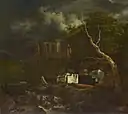 The painting referred to as a duplicate above (considered genuine by later experts) Gemäldegalerie Alte Meister.
The painting referred to as a duplicate above (considered genuine by later experts) Gemäldegalerie Alte Meister.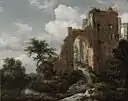

Exhibitions
Rings: Five Passions in World Art
Organized by the High Museum of Art, Atlanta, Georgia, July 4, 1996 - September 29, 1996[18]
The Glory of the Golden Age
Organized by Rijksmuseum, Amsterdam, The Netherlands, April 15, 2000 - September 17, 2000[19]
Rembrandt and the Golden Age: Highlights from the Detroit Institute of Arts
Organized by the Detroit Institute of Arts, Detroit, Michigan
Frist Center for Visual Arts, Nashville, Tennessee, February 1, 2013 - May 19, 2013[20]
See also
References
- 1 2 3 4 5 6 7 8 9 10 11 12 13 14 15 16 17 18 19 20 21 22 Scheyer, Ernst (1977). "THE ICONOGRAPHY OF JACOB VAN RUISDAEL'S "CEMETERY"". Bulletin of the Detroit Institute of Arts. 55 (3): 133–146. ISSN 0011-9636.
- 1 2 3 4 5 6 7 8 9 10 11 12 13 14 15 16 17 18 19 20 21 Nadler, Steven (2003). Rembrandt's Jews. University of Chicago Press. ISBN 978-0-226-56737-2.
- 1 2 3 4 "Jacob van Ruisdael, The Jewish Cemetery – Smarthistory". smarthistory.org. Retrieved 2023-04-19.
- 1 2 3 4 Rosenau, H. (1958). "THE DATES OF JACOB VAN RUISDAEL'S "JEWISH CEMETERIES"". Oud Holland. 73: 241–242. ISSN 0030-672X.
- 1 2 3 Rosenberg, Jacob (February 1926). ""The Jewish Cemetery" by Jacob van Ruisdael". Art in America and Elsewhere. 14 (2): 37–44.
- 1 2 Valentiner, W.R. (February 1926). "The Cemetery by Jacob van Ruysdael" (PDF). Bulletin of the Detroit Institute of Arts. 7 (5): 55 – via DALNET.
- 1 2 3 4 "Jacob van Ruisdael, The Jewish Cemetery – Smarthistory". smarthistory.org. Retrieved 2023-04-19.
- 1 2 "The Jewish Cemetery | Detroit Institute of Arts Museum". dia.org. Retrieved 2023-04-19.
- ↑ Zwarts, J. "Het motief van Jacob van Ruisdael's Jodenkerkhof." Oudheidkundige Jaarboek 8 (1928): pp. 232-249.
- 1 2 3 "Introduction: Landscape and the Visual Hermeneutics of Place, 1500–1700", Landscape and the Visual Hermeneutics of Place, 1500–1700, BRILL, pp. 3–22, 2020-12-17, retrieved 2023-05-09
- ↑ Scheyer, Ernst (1977). "THE ICONOGRAPHY OF JACOB VAN RUISDAEL'S "CEMETERY"". Bulletin of the Detroit Institute of Arts. 55 (3): 133–146. ISSN 0011-9636.
- 1 2 3 4 Slive, Seymour (1981). Jacob van Ruisdael. Hans Hoetink, Jacob van, or 1629-1682 Ruisdael, Mark Greenberg, Mauritshuis, Fogg Art Museum. New York: Abbeville Press. ISBN 0-89659-226-X. OCLC 8140616.
- 1 2 Ruisdael, Jacob van (1650–1655), Landscape with the Ruins of the Castle of Egmond, retrieved 2023-05-09
- 1 2 "Jacob van Ruisdael, The Jewish Cemetery – Smarthistory". smarthistory.org. Retrieved 2023-04-19.
- ↑ Locquet, Pieter; Smit, Jan Willem (1783). Catalogus van schilderyen, als meede zeer fraaye rariteiten : bestaande in stand en borstbeelden, groepen, vaasen, basrelieven en ornamenten, kostbaare Japanse, Chineesche, en Oost-Indische beelden, beeldwerken, figuren, ... zeldzaam hedens in yvoor, parlemoer, schilpad, speksteen enz. ... : uitmakende het beroemd en uitmuntend kabinet van wylen den wel ed. Heer Pieter Locquet, benevens een korte beschryving der schilderyen, rariteiten enz. en de naamen der heeren koopers en pryzen : alles verkocht door de makelaars Philippus van der Schley, Jan de Bosch, Jeronimusz., Cornelis Ploos van Amstel, J Cz., Hendrik de Winter, en Jan Yver, op maandag den 22 september 1783, in het Oudezyds Heeren Logement (in Dutch). Getty Research Institute. Te Amsterdam : By Jan Willem Smit, boekverkoper, op de Fluweele Burgwal, by de Hilsteeg. p. 23.
- 1 2 Hofstede de Groot, D. (1912). A Catalogue Raisonné of the Works of the most Eminent Dutch Painters of the Seventeenth Century, based on the work of John Smith (Vol. 4 ed.). London Macmillan. pp. 74, no. 219.
- ↑ Smith, J. (1829). Catalogue Raisonné of the most eminent Dutch, Flemish, and French Painters (Vol. 6 ed.). London: Smith and Son. pp. 25, no. 60.
- ↑ Rings: Five Passions in World Art. Exh. cat., High Museum of Art. Atlanta, 1996, p. 144.
- ↑ The Glory of the Golden Age. Exh. cat., Rijksmuseum. Amsterdam, 2000, pp. 226-227, 326, cat. 155.
- ↑ "Rembrandt and the Dutch Golden Age: Highlights from the Detroit Institute of Arts". Frist Art Museum. Retrieved 2023-11-03.